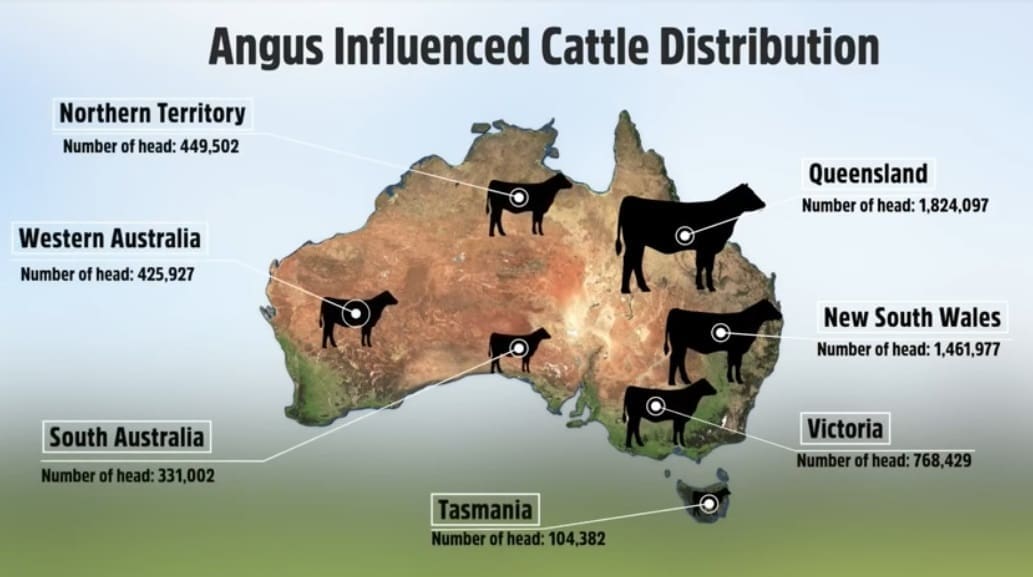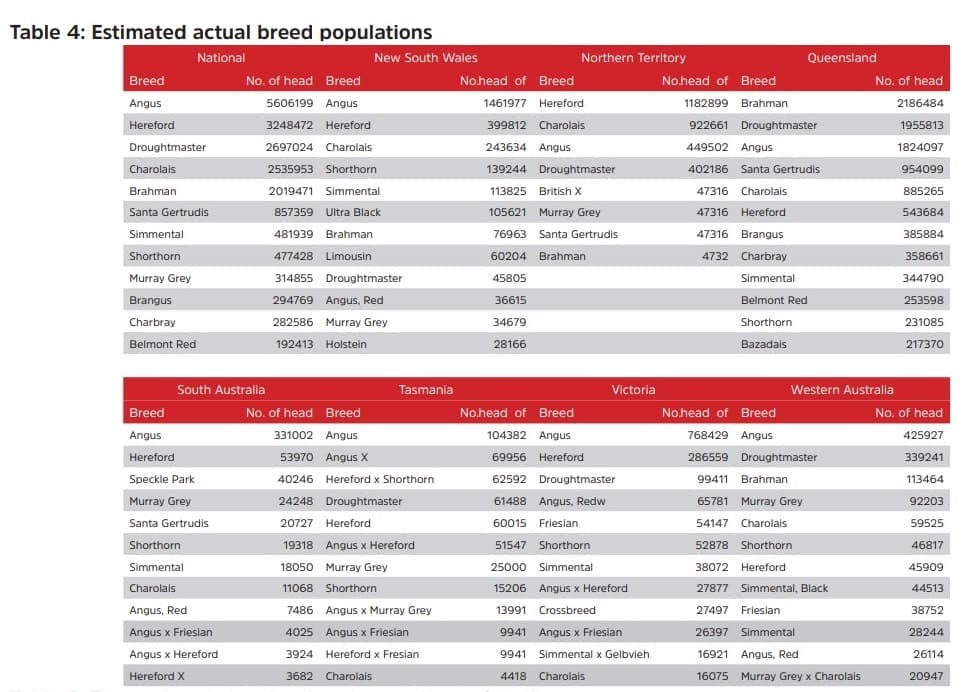
A recent survey of cattle producers found that 48 percent of all breeding females in Australia are Angus-influenced, including a ‘substantial penetration’ in Northern Australia.
The survey was conducted last year by an independent market research group as part of an MLA Donor Company and Angus Australia co-funded project, and was primarily focused on collecting baseline data on producer’s breeding preferences, genetic technology adoption and to quantify the level of Angus penetration in the Australian beef industry.
The data represented a sample of more than 1000 Australian beef producers, 406,000 head of beef cattle and 108 different breeds and their crosses.
The results identified that about 5.6 million breeding females in the national beef herd are influenced by Angus genetics, accounting for 48pc of the beef breeder population.
In another key component of the survey, participants were asked to rate the importance of a range of traits and information that are available to select bulls. The survey highlighted that for those whom participated, temperament is considered the most important bull selection criteria by cattle producers.
The survey was primarily undertaken to produce baseline values on which to gauge practice and attitude change over a five-year period to 2023, when a second quantitative survey will be undertaken.
Of the 5.6 million breeding females in the national beef herd that are influenced by Angus genetics, about 2.4 million (43pc) are purebred Angus. Based on their influence, Angus was the most utilized breed in all states and territories except Queensland and the Northern Territory.
Due to the sheer number of cattle in the state, the largest populations of Angus influenced females resided in Queensland (1.8 million head) – despite Angus being the third most utilised breed. However, in terms of herd proportion, Angus influence was most significant in South Australia and New South Wales (78pc) and Victoria (77pc).
In commenting on the survey findings, Angus Australia chief executive officer Peter Parnell said while the survey had successfully provided essential baseline data to enable future evaluation of the impact of Angus Australia’s research and adoption initiatives, it also clearly showed that the influence Angus genetics was such that the benefits of these initiatives would have a significant impact on a large segment of the Australia beef industry.
“The results strongly demonstrated the influence of Angus genetics in northern Australia and endorsed the importance of Angus Australia’s Northern Development Program being led by Jen Peart (Northern Development Officer) based in central Queensland,” Dr Parnell said.
Temperament priority
In another key component of the survey, participants were asked to rate the importance of a range of traits and information that are available to select bulls. The survey highlighted that for those who participated, temperament was considered the most important bull selection criteria by cattle producers.
Producers in all states listed temperament as the most important of bull selection criteria, except for those in South Australia which prioritised polledness and Northern Territory which valued BullCheck, which on a national basis came in as second and third, respectively.
Given the known implications that poor temperament poses, to both individual bulls and to the wider herd through its progeny – the importance producers gave this trait was well placed, Angus Australia said.
The benefits of good temperament are widely documented and acknowledged within industry. These include lower production costs, easy handling and reduced damage, injury and OH&S risk. Performance is also expected to be superior in environments such as feedlots, during situations such as trucking and result in better eating quality with decreased risk of dark cutting at slaughter.
The Australian Beef Breeding Insight report can be accessed here.
A number of Beef Central readers have commented on clear inaccuracies in surveyed herd composition in states and territories published in the table above, extracted from the report.
Beef Central received this response from Angus Australia:
The report is based off a survey of 1,023 Australian beef producers, conducted independently of Angus Australia, during which great effort was taken to ensure a significant sample size was collected, at state and national level.
The survey data was interrogated and reported with complete objectivity. As outlined in the article, the main reason for the survey is to develop baseline data to enable future evaluation of the impact of Angus Australia’s research and adoption initiatives.
The methodology section of the report outlines how the data was collected and interrogated including the number of responses captured per state or territory. For example – you can see that the Northern Territory only had a small sample size of 6 respondents. Rather than publishing nothing for the NT, it was decided to reflect what had been captured and highlight the number of respondents per state or territory as an explanation for any perceived anomalies.
Angus Australia felt it important to share the results of the survey as both Angus Australia member and Australian taxpayer funds contributed to the project. Readers are encouraged to read the full report, to put the above table in better context.
Jen Peart, Northern Development Officer, Angus Australia


Interesting. Earlier items gave Wagyu’s 10% of the Australian beef matings but the breed doesn’t appear here. The percentage figure is a guess because we apparently have no idea of how many cattle are in Australia.
Droughtmaster the third largest breed in Victoria???
Thanks for your comment, Alex. Readers have pointed out a number of obvious inaccuracies in the table published in the article from the report. Check the Brahman numbers and Hereford numbers in the NT, for example. Looks very much like extreme sample bias in the survey, but we have asked the authors to report back. We’ll add their response at the bottom of the article as soon as it arrives. Editor